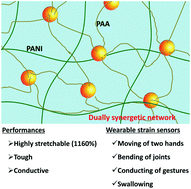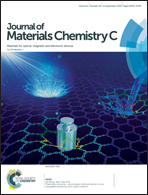Extremely stretchable and electrically conductive hydrogels with dually synergistic networks for wearable strain sensors†
Abstract
Flexible strain sensors are highly used in soft robotics, human–machine interfaces and health monitoring devices. However, it is still a big challenge to construct strain sensors with excellent mechanical properties and broad sensing ranges. In this study, a class of extremely stretchable and electrically conductive hydrogels with dually synergistic networks are fabricated for wearable resistive-type strain sensors. Dually synergistic networks are composed of a soft poly(acrylic acid) (PAA) network and a rigid conductive polyaniline (PANI) network. The PAA network is crosslinked by amphiphilic block copolymers, and the PANI network is chemically doped and ionically crosslinked by phytic acid and these two networks are further interlocked by physical entanglements, hydrogen bonds and ionic interactions. The resulting hydrogels have high tensile strength, controllable conductivity and large tensile deformation (1160%). Moreover, these hydrogels are utilized for fabricating strain sensors with good sensitivity and a wide sensing range (0–1130%). The high performances of hydrogels make such strain sensors suitable for wearable devices monitoring both subtle and large strains induced by human motions, including moving of two hands, bending of joints, conducting of gestures and swallowing.



 Please wait while we load your content...
Please wait while we load your content...